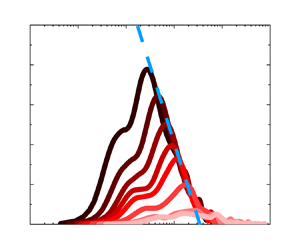Article contents
Wall-attached structure characteristics of flow and dust concentration fields in high-Reynolds-number particle-laden flows
Published online by Cambridge University Press: 06 May 2024
Abstract

The wall-attached structure characteristics of flow and dust concentration fields are investigated in this study based on high-Reynolds-number ( $Re_{\tau } \sim O(10^{6})$) synchronous multiphase observations from the Qingtu Lake observation array site (recorded by Liu et al., J. Fluid Mech., vol. 957, 2023, A14). The results show that not only the particle-free flow field but also the particle-laden flow and dust concentration field contain wall-attached structures. The linear coherence spectrum, as a data-driven filter, is adopted to separate the wall-attached portions from the premultiplied spectra. The decomposed spectra for wall-attached structures in streamwise velocity fluctuations under particle-free and particle-laden conditions show obvious outer-scaling and wall-scaling at large-scale and medium-scale ranges, respectively, but the spectra of dust concentration exhibit only wall-scaling rather than outer-scaling. The streamwise length of the most significant wall-attached dust clustering structures in the logarithmic region is approximately five times the boundary layer thickness, and does not change significantly with height. Furthermore, the streamwise turbulence intensity for wall-attached portions follows the universal Townsend–Perry constant, without particle mass loading effect. Correspondingly, the wall-attached portions of the dust concentration also exhibit universal logarithmic decay slope. The remaining non-attached portions for the turbulent velocity and dust concentration have significant dependence on the particle mass loading.
$Re_{\tau } \sim O(10^{6})$) synchronous multiphase observations from the Qingtu Lake observation array site (recorded by Liu et al., J. Fluid Mech., vol. 957, 2023, A14). The results show that not only the particle-free flow field but also the particle-laden flow and dust concentration field contain wall-attached structures. The linear coherence spectrum, as a data-driven filter, is adopted to separate the wall-attached portions from the premultiplied spectra. The decomposed spectra for wall-attached structures in streamwise velocity fluctuations under particle-free and particle-laden conditions show obvious outer-scaling and wall-scaling at large-scale and medium-scale ranges, respectively, but the spectra of dust concentration exhibit only wall-scaling rather than outer-scaling. The streamwise length of the most significant wall-attached dust clustering structures in the logarithmic region is approximately five times the boundary layer thickness, and does not change significantly with height. Furthermore, the streamwise turbulence intensity for wall-attached portions follows the universal Townsend–Perry constant, without particle mass loading effect. Correspondingly, the wall-attached portions of the dust concentration also exhibit universal logarithmic decay slope. The remaining non-attached portions for the turbulent velocity and dust concentration have significant dependence on the particle mass loading.
Information
- Type
- JFM Papers
- Information
- Copyright
- © The Author(s), 2024. Published by Cambridge University Press
References
- 2
- Cited by


